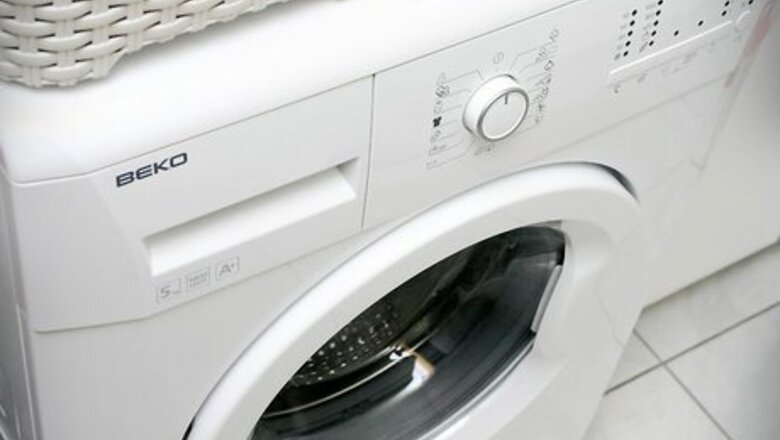
views
- Set your washing machine to the longest, hottest cycle and let it fill with water. Then, add 4 cups (950 ml) of white vinegar and 1 cup (220 g) of baking soda into the drum.
- Agitate the water and let it soak for 1 hour. Then, clean the bleach, detergent, and fabric softener wells with a toothbrush or a sponge.
- Wipe the sides and bottom of the drum with a rag after the cycle finishes.
Top-Load Machine
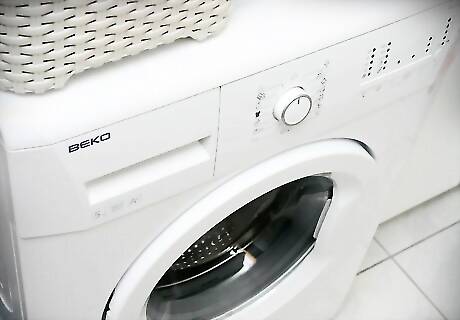
Set your machine to the longest and hottest cycle. Turn the dials to the largest load size to fill your washer with water. Use the “heavy duty” wash cycle if you can’t manually set the amount of time your washer runs. Set the temperature knob to the hottest wash setting, then press start so the drum starts to fill with water, and keep the lid open. If your machine has a “drum clean” cycle, use that setting instead. EXPERT TIP Ashley Matuska Ashley Matuska Professional Cleaner Ashley Matuska is a Professional Cleaner at the Founder and Owner of Dashing Maids in Denver, Colorado. Ashley has over seven years of experience in the cleaning industry. She and her team specialize in offering sustainable deep cleaning and maintenance cleaning services. Ashley Matuska Ashley Matuska Professional Cleaner How often you clean your washing machine depends on how often you use it. Ashley Matuska of Dashing Maids says: "I personally do about 10 or so loads of laundry a week, so I clean my washing machine about once a month. If you use your machine less often, clean it every other month. To clean it, run a load on the sanitize setting, or for an older model, set it for a larger load or longer setting with hot water."
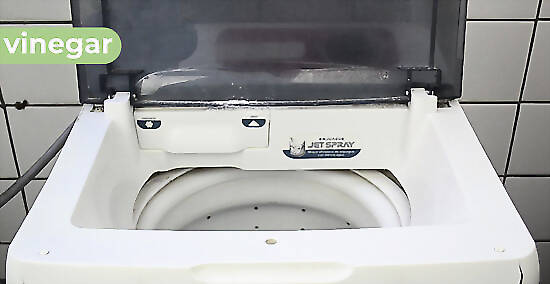
Add 4 cups (950 ml) of white vinegar to the drum. Any standard white vinegar you have in your kitchen will work fine. As the drum fills with water, pour the vinegar inside your machine. Purchase a container of vinegar to strictly use for cleaning purposes so you don’t have to go to your kitchen whenever you want to clean.
Pour 1 cup (220 g) of baking soda into the water. Add the baking soda while the water fills the drum so it mixes throughout the machine. The baking soda will react with the vinegar to lift any residue and clean the inside of your machine. Keep a box of baking soda in your laundry room separate from the baking soda you use for cooking. That way, you’ll be able to make the solution whenever you need it.
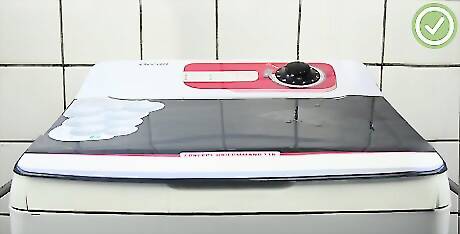
Agitate the water and let it soak for 1 hour. Close the lid on the machine for 1 minute so the cycle can start. This will mix the baking soda, vinegar, and water more thoroughly and get your cleaning solution distributed throughout the entire drum. After a minute, lift the lid back up to pause the cycle. Some washing machines will lock the lid once the cycle has started. Press the stop or pause button to unlock it and open the lid. Add a few drops of essential oil into the drum while you clean it to leave a fresh smell in your washing machine. Many essential oils, like tea tree, cinnamon, lemon, and mint, have antifungal and antimicrobial properties, so they’ll also help destroy the source of any bad odors.
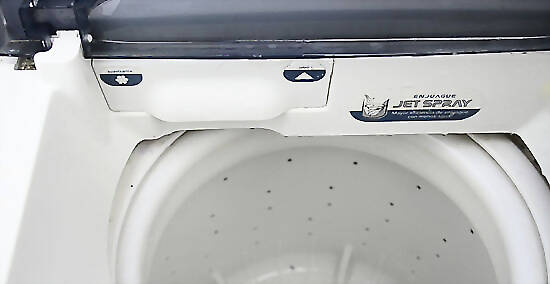
Clean the bleach, detergent, and fabric softener wells with a toothbrush. Dip the bristles of a stiff toothbrush into the water in your machine and scrub all the wells. Focus on areas that have mold or mildew forming on them. Once you’ve scrubbed them, wipe the grime away with a clean dishcloth. If a toothbrush isn’t working, use a stiff-bristled cleaning brush or a sponge with a scrubber side. Place any removable parts in the water and let them soak for 20 minutes before scrubbing them. Check the plastic seal around the lid. If you notice dirt and grime, scrub the area with a toothbrush.
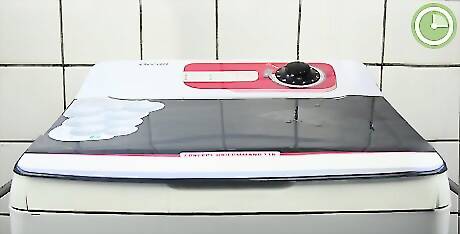
Close the machine and let the cycle complete. Shut the lid and press start on your machine if the cycle doesn’t immediately resume. Wait until the cycle is finished and the drum is drained of the solution. Clean the sides and top of your machine with a damp rag while your cycle is running to make the best use of your time.
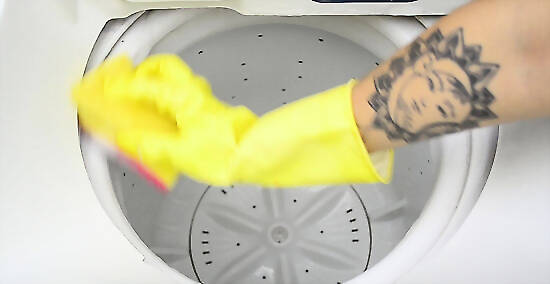
Wipe the sides and bottom of the drum after the cycle finishes. Use a clean dishrag to wipe any residue off your machine's interior. If needed, dip 1 end of the rag into a mixture of 3 parts warm water and 1 part vinegar to scrub any trouble areas. If there is a lot of residue, run another cycle with 4 cups (950 ml) of vinegar to remove it. Keep the lid of your washing machine open in between cycles to prevent mildew and let the drum dry out. Clean your washer every month to keep it fresh.
Front-Load Machine

Remove mildew from the seal with white vinegar and a sponge. Dip a sponge into a bowl of vinegar and scrub underneath the plastic or rubber seal around the door of your washing machine. If the mildew doesn’t come up, soak it with vinegar for 20 minutes before returning with your sponge. Wipe the seal dry with a piece of paper towel. Use a stiff-bristled toothbrush on resilient mold or mildew.
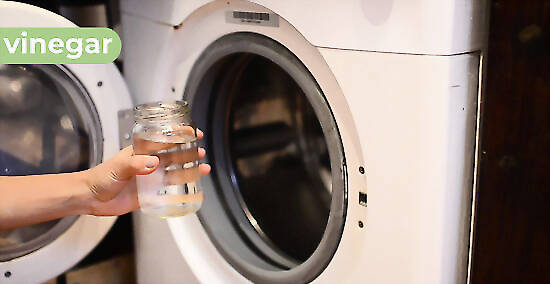
Pour 2 cups (470 ml) of white vinegar into the drum. Put the vinegar directly into the bottom of the drum. Close the door to the washing machine before moving on. If you notice a lot of grimy buildup, add another ⁄2 cup (120 ml) of vinegar to help loosen it up.

Pour warm water and baking soda into the detergent well. In a small bowl, mix ⁄4 cup (59 ml) of water with ¼ cup (55 g) of baking soda. Once the solution is combined, pour it directly into the wells where you would put detergent, fabric softener, and bleach. This way, all the wells are cleaned when you run the machine. If you use powder detergent, place the ¼ cup (55 g) directly into the powdered detergent well.
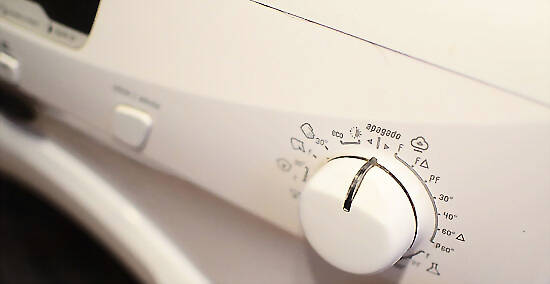
Run a normal cycle with hot water. Set the temperature of the cycle to the hottest setting your machine allows. Use the normal cycle you would for clothes or a heavy-duty cycle so the cleaner has more time to soak into the drum. The heat combined with the vinegar and baking soda will loosen and destroy any mildew or grime left inside the drum.

Use a dampened cleaning rag to wipe the drum clean when it’s finished. Use a rag dampened with clean water to wipe away any excess grime or mold inside your washing machine. If there is any mildew present, use a scouring brush to scrape it off. Check your washing machine’s filter for lint, pulling out any built-up debris if necessary. Repeat the cleaning process once monthly so your washer stays clean.




















Comments
0 comment